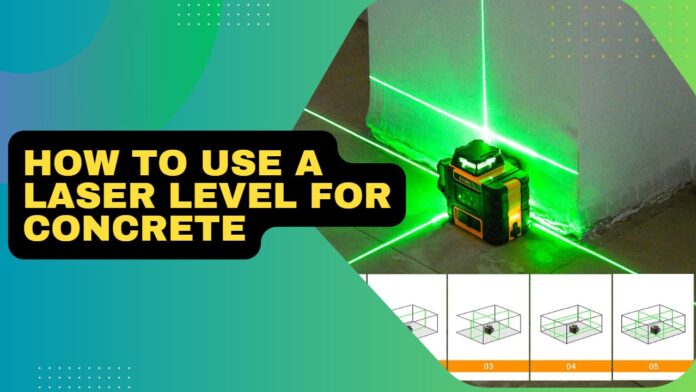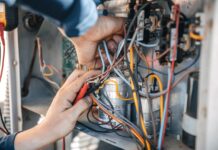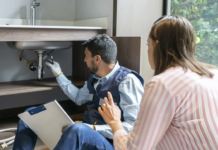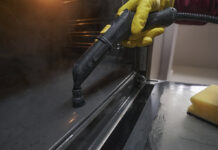A laser level is one of the best tools for construction workers to use when attempting to level concrete accurately. A laser level provides unrivaled accuracy and eliminates the need for multiple people to perform leveling tasks on-site. You’ll be able to save time and energy while remaining confident in your results with this tool. In this blog post, we’ll go over the techniques you can employ with a laser level to ensure your job is done correctly and efficiently every time!
What is a laser level, and how does it work?
A laser level tool is used in construction, surveying, and carpentry to measure and maintain level surfaces accurately. It works by projecting laser light onto a surface, creating an easy-to-follow straight line that can be used to ensure that the surface remains level. Laser levels are often equipped with features such as bubble vials and adjustable bases for greater accuracy.
Laser levels use lasers of various strengths to project their lines and run on a battery or mains power supply. Most modern laser levels use red or green lasers, which offer higher visibility than traditional white ones. The most common type of laser level uses two rotating beams perpendicular to each other to create 90-degree angle points across horizontal or vertical surfaces.
Since laser levels are so accurate, they are perfect for tasks like laying tiles or measuring long distances. They are also used in surveying and construction projects to ensure that the surfaces being worked on remain level and straight. Laser levels can detect variations of up to 1/16th of an inch across a distance of 100 feet. This makes them an invaluable tool for ensuring accuracy in all types of projects.
In addition to their accuracy, laser levels can be easily adjusted using telescopic stands or tripods for added flexibility and convenience. Using these devices, users can adjust their laser level’s height or angle quickly and accurately, allowing them to get the perfect measurement every time.
Laser levels are an essential tool for any professional working with level surfaces. Combined with its ease of use, accuracy, and adjustable features, it’s no wonder that laser levels have become a staple in the construction industry. With the right model and accessories, anyone can benefit from the precision and convenience provided by a laser level.
Common mistakes people make when using a laser level
Not allowing the laser to settle:
It is important to allow your laser level enough time to settle before taking a measurement or starting a project. This gives the system time to lock into its target and get an accurate reading.
Not checking for accuracy:
Before beginning any project, you must check the accuracy of your laser level. Ensure that all the components are functioning correctly and that the readings you’re getting from your device are precise and accurate.
Using incorrect batteries:
If your laser level is not working, you should change out the batteries with fresh ones from an authorized supplier as counterfeit batteries can cause damage to your device and prevent it from working correctly.
Not using the correct mounting system:
When using a laser level, it is important to use the correct mounting system for your device to ensure accuracy. Ensure you use the appropriate tripod and mount for your particular model.
Pointing the laser at reflective surfaces:
To get accurate readings, it’s best not to point your laser level at any reflective surfaces, such as mirrors or windows, as this can cause errors in measurement and misinterpretations of readings.
By following these tips and avoiding common mistakes, you can be sure you will have an accurate and efficient experience using a laser level!
How to Use a Laser Level for Concrete?
Using a laser level for concrete is a good way to ensure your project is done as accurately and precisely as possible.
Here are some basic steps for using a laser level on concrete:
- Place the tripod in a stable position on the ground and extend it if needed. Set up the laser level on top of the tripod and ensure it is secured properly.
- Position yourself according to where you will work with the line of sight of the laser beam across your work area. When ready, turn the power switch off your laser level to “on” and check that it emits its bright dot or plane onto your surface correctly.
- If necessary, adjust by turning knobs or dials on the laser level to move the dot or plane so that it is perpendicular to your surface.
- Finally, use a line marker or straight-edge ruler to trace out the laser beam’s path onto your concrete surface as a reference.
Following these simple steps, you can effectively use a laser level for accurate measurements and alignment when completing any project on concrete surfaces. It is always important to ensure proper setup for accuracy and safety purposes. Always double-check your work before continuing with any further tasks.
Frequently Asked Questions:
Do I need a tripod for the laser level?
Yes. Using a tripod to set up your laser level during concrete projects properly is essential. Laser levels are sensitive, so they must be set on a firm, stable base to ensure they measure and level things correctly.
Can I use a laser level for interior jobs?
Yes. Properly using a tripod to set up your laser level during concrete projects is critical. Laser levels need to be set on a firm, stable base for accurate measuring and leveling.
Are there different types of laser levels available?
Many laser levels are available, from simple hand-held models to complex multi-axis rotary lasers. Some of the more common laser levels are line lasers, cross-line lasers, point lasers, and rotary laser levels. It is critical to choose the right one for your project; if you are still determining which type is best for your needs, seek professional advice.
What safety precautions should I take when using a laser level?
When using any tool, it is critical to be aware of safety precautions to reduce the risk of injury or damage. When working with a laser level, make sure to wear protective eyewear because the laser beam can be harmful to your eyes. Furthermore, you should always check the room for any obstructions that may interfere with the level’s accuracy and avoid using it near combustible substances such as gasoline or aerosol sprays. Never look directly into the laser’s beam; always turn it off when not in use.
Can I use a laser level outdoors?
Yes, many laser levels are designed for outdoor use as long as there is enough light – direct sunlight may cause glare on surfaces, so work early in the morning or later in the afternoon/evening if possible. Keep an eye out for windy or rainy weather, which can affect the accuracy of your measurements, so exercise caution when using your laser level outside.
Is a laser level precise enough for concrete projects?
Laser levels can be extremely precise when used correctly, making them an excellent choice for concrete projects. Before beginning work, ensure accuracy and that the tripod and base are firm, level, and stable. Additionally, ensure that there is enough light in the room and that no obstructions could interfere with the beam. You should achieve accurate measurements every time you follow these steps.
Conclusion:
When using a laser level for concrete, it is critical to remember always to follow safety precautions and wear the appropriate protective equipment. Avoid directing the laser beam directly at your eyes, resulting in temporary or permanent vision loss. Furthermore, please exercise caution when transporting the laser level and keep it away from children and pets. Lastly, ensure you take breaks often while using the laser level and know how to use it correctly before you start any concrete projects. Following these guidelines will ensure a positive experience when using a laser level for concrete work.


















